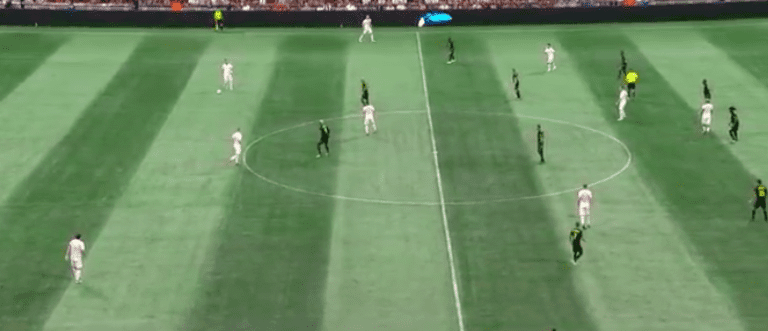On Monday, US men's national team head coach Gregg Berhalter told reporters down in Orlando, the site of the team’s game vs. Ecuador on Thursday (8 pm ET | ESPN2, UniMás, UDN), that he projects to use Tyler Adams as a right back in the upcoming game.
Let’s start with what this means for the team as a whole. Gregg Berhalter plans to continue to use the morphing 4-3-3/3-4-3 system, with a hybrid right back/center midfielder. That might not seem like news, but it’s news. On one hand, it would have been a weird system to try in January camp and not continue. It’s not exactly a “Hey, let’s get to know each other” formation; it’s more of a long-term commitment setup.
On the other hand, it’s not the obvious choice, either. It demands possession and control of the ball, and generally requires rehearsed coordination of movements between players. Does the national team schedule afford a coach enough time to coach those details? Are the field surfaces in Concacaf flat enough to play controlled possession? Does the US have technical enough players to play possession against non-Concacaf teams? If the answer to any of those questions is no, then there’s a ton of space for opponents to exploit in transitions.
Berhalter appears to be banking on the answers being yes. So the hybrid right back position continues! And it looks like Tyler Adams gets it, at least in the upcoming game against Ecuador.
Charlie Davies on Adams' position
Why is Adams, who was one of the best defensive midfielder in MLS in 2018 and has taken the same form to the Bundesliga in 2019, moving to “right back”?
Let’s break down the different parts of the role under Berhalter, and how they relate to Adams.
Defending
There are two elements to a team’s defensive gameplan: set shape and transitions after the team loses the ball.
When Berhalter’s teams get into a set defensive shape, he prefers to have them drop back into a middle block. This is basically the only time in the game when Adams would be located in the right back area. Whereas other teams, like the New York Red Bulls and RB Leipzig, pressure the ball high to create chaos and turnovers, Berhalter’s Columbus Crew SC prioritized staying compact, blocking passing lanes and restricting space in the middle. Using a line of confrontation near the midfield line, the Columbus Crew led MLS in fewest expected goals against in 2018.
Within a structured middle block, Adams’ primary defensive qualities — ground coverage, closing speed and duels — aren’t quite as useful. The center midfielder doesn’t have a lot of ground to cover. The key attributes for center midfielders are awareness and positioning, mostly to ensure passing lanes are blocked. A player like Wil Trapp could actually be better in the role (or at least it’s a smaller margin than most would expect). As a result, it’s not necessarily a net loss to move Adams’ from the middle in the set shape.

Adams’ defensive qualities matter more in transition — the moments when the team loses the ball — in Berhatler’s system and Adams will still be in the midfield for transition moments. The right back moves up to function as a center midfielder in possession (and the 4-3-3 changes to a 3-4-3). As Berhalter told reporters, “if we can control the game how we want to control the game, he’s going to be up in a 2-3 while we are attacking in a position to win the ball back right away. ... and that’s right in his skill set.”
In other words, every time you would want Adams in the midfield to do the things he does for his club, he will be in the midfield. Rest easy, you’ll still see Adams flying around to win the ball.
Attacking
Still don’t love the idea? All of this needs to be paired with the second part: Adams’ role in possession. Berhalter’s system uses three clearly defined roles for the center midfielders in the attack. One drops deep, gets the ball off the defenders and acts as the teams anchor, and Berhalter seems to prefer a “controlling” player there, as he calls it (presumably Trapp or Michael Bradley). The other two center midfielders stay higher to stretch the space and find room between the lines. Sometimes one of the two higher players drops deeper to help the defensive midfielder, but ideally he stays farther forward. Instead of him dropping deep, the right back moves from the wide space toward the middle. And this is where Adams’ ability becomes so valuable.
That right back-turned-center mid has the most freedom and responsibility. He’s responsible for reading the game and providing the overloads, the key moments to either get out of trouble or cause trouble. To use Berhalter’s words, as mentioned in Doug McIntyre’s story for Yahoo!:
“We want to use him as a right back that comes inside and stays wide,” Berhalter said. “We think there’s advantages to gain in wide areas of the field, and we think he can do it. We’ve seen him pulling away in central midfield sometimes with Red Bull and getting on the ball and being able to penetrate.
“He’s not going to be in the back,” the coach continued. “He’s going to be forward, at the top of the penalty box, or he’s going to be combining in the wide areas, and that’s right in his skill set."
The idea that moving Adams to right back hinders him in some way is wrong (at least philosophically). It’s the opposite; it provides him the most freedom to impact the game in the most ways. If the defensive midfielder needs help in possession, Adams can move inside next to him; if the wing needs an option to create a numerical advantage, Adams can split wide; if there’s a cross coming into the box, Adams can make a late run.
Yes, Adams could be used as the controlling player to start the possession. Yes, he could be used higher on the field to play around the box. The hybrid right back spot allows him to do both. Berhalter is trying to unleash Adams, not hinder him.
It might not the be long-term answer, but it’s absolutely worth trying.











